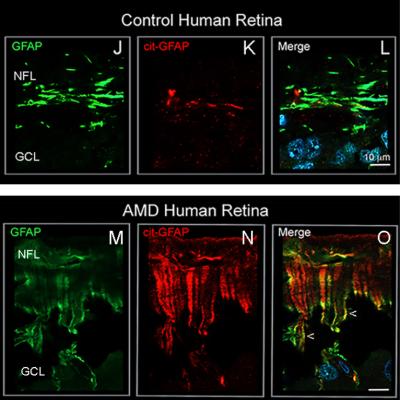
Healthy aged human retinas (J,K,L) have minimal stress proteins (green, J), little citrullination (red, K) and very little overlap (L), indicating low stress levels. In contrast, human retinas with advanced age-related macular degeneration produce abundant levels of stress proteins and increased citrullination (M, N) in Muller glia end feet, where extensive overlap between the two processes is seen (O). (Royce Mohan/UConn Health)
A team of neuroscientists at the University of Connecticut reported that the retina has a remarkable ability to wall off damage. The walling-off or “bunkering” of the damage may be key to preserving our eyesight.
Royce Mohan and colleagues discovered that the endfeet, a specialized zone in Muller cells, is where proteins become modified when the retina is under stress. The modification is called citrullination - when the amino acid arginine is changed into citrulline, which has been linked to cellular dysfunction and autoimmune disease.
While Muller glia span the thickness of the retina, their endfeet are on the side of the retina opposite the light-sensing photoreceptors. The researchers propose in a paper published in PNAS that this segregation of the endfeet and light receptors may permit light detection to continue even as the retina responds to stress.
The researchers also identified that the endfeet citrullination process is controlled by an enzyme known as peptidyl arginine deiminase-4 (PAD4). Small molecule inhibitors of PAD4 have been developed for other types of citrullination-dependent diseases, such as rheumatoid arthritis. Mohan believes that such therapeutic agents could be applied to reduce citrullination at early stages of AMD and spare the retina of undesired responses to this protein modification.